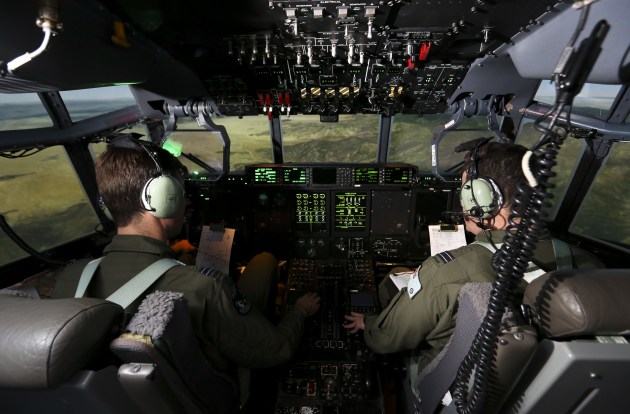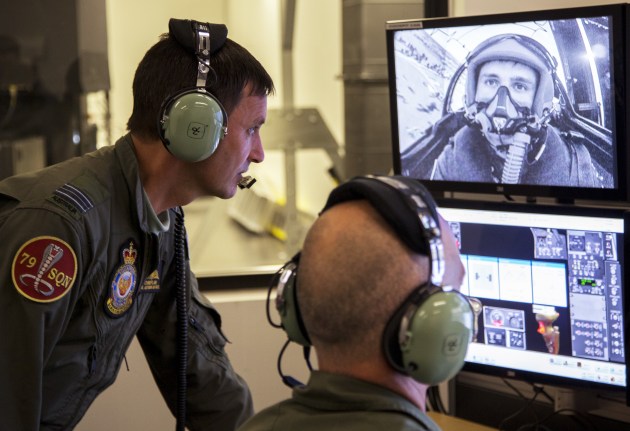After more than 20 years as the primary provider of support services for the ADF’s aerospace simulators, CAE Australia now seems likely to extend these and integrated training capabilities into a future in which advanced digital immersion technologies will play a vital role.
CAE’s two main umbrella contracts for simulator sustainment are due to expire this year and at the time of writing the company was preparing to enter negotiations with the Commonwealth on the construct of a future single umbrella contract.
Any new contract is likely to encompass simulator support to the Hawk Mk.127 lead-in-fighter at RAAF Williamtown and RAAF Pearce, C-130J-30 tactical airlifter at RAAF Richmond, KC-30A multi-role tanker transport at RAAF Amberley, MRH 90 Taipan battlefield helicopter at Army’s Oakey Aviation Training Centre and the 5th Aviation Regiment at Townsville, and the AP-3C(EW) at RAAF Edinburgh.
In addition, CAE Australia supports the RAN MH-60R naval combat helicopter training academy at HMAS Albatross, the King Air 350 simulator at RAAF East Sale, and the Toll Aeromedical Centre of Excellence at Bankstown under separate agreements.
At a number of these sites CAE has become more of a training systems integrator, delivering the management of facilities, courseware, instructional delivery and in-flight training with the simulators as an integral part of the training curriculum.
“The training outcomes required by the Commonwealth across our centres is quite diverse,” explained Matthew Sibree, Brisbane-based Managing Director of CAE Indo-Pacific Defence and Security.
“The KC-30A training is for both pilots and air refuelling officers (AROs); at RAAF Richmond we deliver C-130J training in aircraft and simulators together with a fuselage trainer, the pilot and loadmaster training environments and the maintenance training environment.
“At Nowra we have instructors as well as device maintainers. The work is subcontracted to CAE USA who then interface with the US Navy because of some of the sensitivities around the MH-60R.
“At Williamtown and Pearce our Hawk simulator instructors generally double up as RAAF Reserve pilots, which allows us to attract a very high calibre of instructors who remain current across operating procedures and take that back to the sim. On the C-130J, CAE delivers training both in the live aircraft and the simulators.
“At Townsville we subcontract the device sustainment scope of work to Thales. Across the MRH 90 the Commonwealth retains uniformed instructors.”
The Army’s CAE-manufactured Black Hawk simulator, commissioned at Oakey in 2008 and described at the time as the world’s most advanced helicopter simulator, was retired earlier this year after 27,000 hours usage. By contrast, the heaviest-flown Black Hawk notched less than 6,000 flight hours.
Cutting edge technology
As an example of how government and industry can partner to deliver cutting-edge technologies, CAE Australia and technology company Seeing Machines recently collaborated to install and integrate a crew training system that features precision eye-tracking technology on the three CAE-built Hawk Mk.127 full-mission simulators used as part of the RAAF’s lead-in fighter training program at RAAF Bases Williamtown and Pearce.

The eye-tracking technology improves aircrew training by providing objective insights and detailed data on where pilots are looking during training sessions in the simulator.
“We believe with further research we can understand through the analysis of a student’s biometric data we can assess cognitive capacity and where they sit on the learning curve,” Sibree said.
“Through a combination of Artificial Intelligence and adaptive training scenarios, simulated missions can be tailored to a student’s learning capacity to optimise both training outcomes and reduce the time taken to train.
“In historical training, every pilot either passed or failed in a certain period of time and everyone went through the same training curriculum. With tailoring, if you’ve got a really good student, you can accelerate them through the curriculum whereas if you’ve got someone who just takes a little longer to learn, you can adjust the scenarios accordingly.”
COVID-19 had initiated new approaches such as offboard instructor operator stations, virtual instructor-led classroom training and remote acceptance testing on training devices, Sibree noted.
However, it had also accelerated trends to which defence forces were moving already – digital immersion technologies like virtual reality; leveraging synthetic environments for not just training, but also planning, analysis and decision support; and looking more holistically at multi-domain operations and the integration of air, land, maritime, space and cyber.
“We need to prepare for a future that is contested in a multi-domain environment with a peer or near-peer adversary, and a secure virtual world will be the only way to do so because of time, cost and the prying eyes of adversaries,” Sibree stated.
“The challenges for all air forces going forward are that aircraft and live flight are not getting any cheaper, but aircraft are so capable that they cannot not be used in a training area to their full capacity.
“Training was moving more around mission rehearsal in a large force employment exercise. So, getting that distributed mission training environment set up where people or operators can plug and play into a common
synthetic environment is the challenge going forward.
“When you think about the cross-domain security of various devices, Hawk for example is an unclassified device whereas the F-35 is incredibly classified, and when you start mixing those ones and zeroes you need some smart operators to be able to implement the cross-domain security protocols.”
Nevertheless, operators were getting greater value for money from live flight, concentrating on high end aspects with lower end aspects relegated to simulator time.

Emerging trends
One apparent trend however, was a move away from expensive full motion simulators to lower cost devices that still provided high immersion but were less expensive and more transportable.
Emerging technologies such as cloud computing, big data analytics, and artificial intelligence have the potential to transform training and mission support for multi-domain operations, Sibree commented.
CAE was involved in the Mission Command Systems Common Operation Picture for the US Special Operations Command and the Single Synthetic Environment for the UK Strategic Command where cloud-based synthetic environments offer decision support, what-if course of action analysis, and faster than real-time simulation.

The company was also contracted to develop a cloud-based adaptive learning management system for the US Air Force Pilot Training Transformation initiative. This will leverage data analytics, artificial intelligence and machine learning to streamline pilot training and create a training process that is continually adapting and improving.
“What we’re seeing, and we’re not the only defence industry to do so, is the Commonwealth starting to take what they traditionally call a below-the-line defence contractor further up into the above-the-line space, acknowledging there are some areas of capability in which they don’t need to have a deep technical understanding,” Sibree said.
“There they will leverage their partners to provide them with impartial advice and this is where the trusted nature of the relationship comes in.”
Future opportunities
Meanwhile CAE Australia is a training partner in the General Atomics-led Team SkyGuardian Australia selected in November 2019 to deliver the MQ-9B SkyGuardian as Australia’s first armed medium altitude long endurance (MALE) remotely piloted aircraft system (RPAS). The $1.3 billion MQ-9B acquisition proposal is scheduled for government consideration in 2021-22.
CAE has delivered MQ-9A training to the USAF for several years and has worked closely with General Atomics on MQ-9B programmes for the UAE and the Italian Air Force, the latter with what is believed to be the highest fidelity RPAS simulator ever designed. This has been formally qualified to Level D equivalent standard and provides the option to fully qualify both pilots and sensor operators in the simulator with zero live flight time.
The Italian simulator is also the baseline for the mission trainers under development by CAE for the Royal Air Force’ s MQ-9B-based Protector RG.1 RPAS.
In terms of other opportunities, Sibree pointed out that the C-27J Spartan lacked an in-country training system, with COVID presenting challenges for pilots still travelling to Italy to utilise the synthetic devices at the original equipment manufacturer Leonardo in Pisa.
As agreed with the Commonwealth, the CAE-owned and operated King Air 350 full motion simulator at East Sale can also be accessed by third parties – in this instance numerous civilian customers and the RNZAF – providing a rebate back to the Commonwealth for every hour sold and demonstrating a model that could be extended, for example to other platforms with regional operators.
Yet to be disclosed is any training requirement for the MC-55A Peregrine electronic warfare support system capability based on four modified Gulfstream G550 airframes, the first of which will be delivered to the RAAF in 2023.
“We see a potential opportunity here because the flight model and operations will be different from a standard civil G550,” Sibree commented.
Of more immediate interest is the upcoming RAAF requirement under Project Air 5428 Phase 3 for an Air Mission Training System to be located at RAAF Base East Sale. This will train Air Battle Managers, Air Mobility Officers, Air Traffic Controllers, Electronic Warfare Officers, Maritime Patrol and Response officers, Operations Officers and Weapons Systems Officers.
The requirements are similar to the training supported by CAE for non-pilot US Naval Flight Officers (NFOs) at US Naval Air Station Pensacola who are selected for the six-month Advanced Maritime Command and Control course. In parallel, the company is pursuing a major contract with the Canadian government for the RCAF Future Aircrew Training System (FAcTS).
This involves a CAE-designed multicrew simulator (MCS) incorporating crew stations with interactive software running a series of instructor-programmed scenarios designed to facilitate the training of basic NFO skillsets.

Perhaps coincidentally, CAE Australia is now seriously examining taking the experience it has gained in the air domain and also delivering it in the naval space.
This aspiration will benefit from the recent US$1 billion acquisition by CAE of the L3Harris Technologies’ military training business. Among a broad range of capabilities, this brings with it experience in the development and delivery of training systems for submarines.
“There’s a concept coined by Navy called Ship Zero whereby training, sustainment, design engineering, experimentation and test would be undertaken under one roof,” Sibree states.
“Ideally, for each of the new classes of ship there would be a Ship Zero facility that would enable some onshore training to occur.
“We can see CAE playing a part in Ship Zero and we have been in discussions with various elements of Navy to better understand their requirement and where we could add value.
“We currently deliver to the UAE Navy their naval training centre and that integrates several classes of ships in a synthetic environment. That centre also has the capability to then bring ships that are either alongside or at sea into a live, virtual and constructive environment so it’s not new to CAE, it is new to us in Australia, and we see a path we could play there.”








